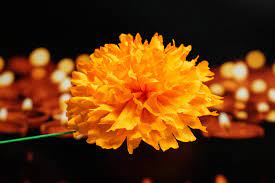
Cempasuchil: A Vibrant Mexican Marigold
Cempasuchil: A Vibrant Mexican Marigold Native to Mexico, the brilliant and culturally significant Cempasuchil flower is also known as the Mexican marigold or Tagetes erecta. It is a well-loved icon in Mexican culture, especially during the festive Day of the Dead celebration when its vivid, golden-orange petals are fully displayed. From its traditional applications to its therapeutic virtues and global popularity, Cempasuchil has a long and fascinating past that we’ll go into here.
Cempasuchil, what is it?
Cempasuchil, or Tagetes erecta in its scientific name, is a member of the daisy or sunflower family, Asteraceae. It resembles a marigold and is distinguished by its many orange petals and dark green, feathery foliage. The Nahuatl word “cempohualxochitl,” from which “Cempasuchil” is derived, means “twenty flowers.”
Cempasuchil’s Cultural Importance
Cempasuchil is more than just a pretty face; it has profound cultural importance in Mexico. Da de los Muertos is a traditional Mexican holiday commemorating and remembering the lives of ancestors and other departed loved ones. Cempasuchil’s brilliant petals are thought to lead the souls of the dead back to the realm of the living.
Cempasuchil on the Day of the Dead
Cempasuchil flowers create intricate arrangements for Da de los Muertos altars and ofrendas (offerings). Paths adorned with these colorful flowers represent the afterlife’s journey to the altars of the living. To further honor the departed, their loved ones often offer the deceased person’s favorite meals and personal items on these altars.
Flowers of the Cempasuchil Cultivar
Because of how simple it is to grow, cempasuchil is frequently used in home gardens. These marigolds need lots of sunlight and soil with good drainage. Proper care makes a year-round supply of fresh, colorful flowers possible.
Cempasuchil’s History of Medicinal Use
Cempasuchil has several cultural uses in Mexico beyond Dia de los Muertos. It has many different services, from weddings to religious celebrations. As a bonus, its petals can be used as a natural dye or to spread over a room to greet guests.
Traditions Regarding Cempasuchil in Mexican Culture
Cempasuchil has gained notoriety in Mexican folklore, where it frequently takes on symbolic meanings of love and ardor. Over the years, its vibrant hues and fragrant flowers have sparked countless tales and legends.
Cempasuchil’s Medicinal Uses
Cempasuchil is prized for its possible therapeutic uses and cultural and aesthetic significance. It has been hypothesized that the plant can reduce inflammation, fight bacteria, and eliminate fungi. Various diseases have been treated with it historically.
The International Fame of Cempasuchil
Although Cempasuchil is steeped in Mexican tradition, its allure has far transcended its borders. Because of its stunning appearance, it is widely used by flower aficionados and gardeners worldwide.
Growing Healthy Cempasuchil Plants
If you want your Cempasuchil plants to thrive, you must give them the attention they deserve. Soil with good drainage, lots of sunshine, and consistent watering are all essential. Maintaining a healthy plant by pruning and deadheading is necessary for prolonged flowering.
Variety of Cempasuchil
There are many varieties of Cempasuchil, each with its own set of desirable qualities. A few examples of well-known types are the “Aztec Gold,” “Crackerjack,” and “Orange Supreme.” These variants feature a plethora of flower colors and sizes.
The Use of Cempasuchil in Creative Works
Not only have gardeners fallen in love with Cempasuchil, but its beauty has also sparked the imaginations of artists and writers. Because of its dual meaning in life and death, the skeleton is a common motif in Mexican art and literature.
Why We Must Protect Cempasuchil
Cempasuchil’s increasing fame makes safeguarding the species all the more critical. This well-known flower is in danger due to deforestation and overharvesting. To ensure its availability for future generations, efforts are being made to preserve and harvest Cempasuchil sustainably.
Conclusion
The brilliant Mexican marigold, or cempasuchil, has deeper meanings than its aesthetic appeal. Cempasuchil continues to amaze people worldwide, whether it be used to decorate ofrendas for Dia de los Muertos, treat illness, or as an inspiration for art and literature. The world of horticulture and tradition stands to gain from its preservation just as much as Mexico’s cultural tapestry.
FAQs
When celebrating Dia de los Muertos, what does Cempasuchil represent?
During Dia de los Muertos, cempasuchil is burned to help the souls of the dead return to the world of the living.
Is it possible to cultivate Cempasuchil outside of Mexico?
If given the proper attention and environment, Cempasuchil can be grown in many different places.
Is there a wide range of Cempasuchil flowers available?
Several different Cempasuchil cultivars exist; its petals come in a wide range of hues and sizes.
What are some of Cempasuchil’s traditional medical applications?
Because of its possible anti-inflammatory, antibacterial, and antifungal characteristics, cempasuchil has been used traditionally to treat a wide range of conditions.
Please tell me what I can do to help protect Cempasuchil.
For Cempasuchil to survive, we must back sustainable harvesting practices and work to keep its natural habitat safe.

Cempasuchil: A Vibrant Mexican Marigold

